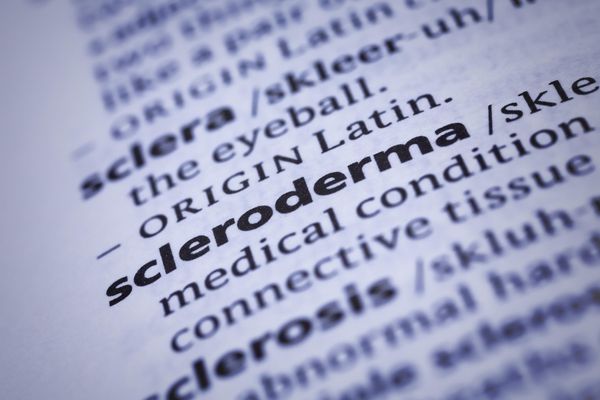Q:
How is scleroderma treated?
A:
As with many chronic illnesses, there is no cure for scleroderma. However, there are effective treatments for many of the symptoms. Treatment will be determined by the type and severity of your symptoms. If you have been diagnosed with scleroderma, you may need to consult a team of health care professionals, including a rheumatologist and a dermatologist.
Some treatments may work on one patient and not another, and some may lose their effectiveness over time. What makes identifying successful treatments particularly difficult is that scleroderma can sometimes go into unexplained remission, which may give the impression that a particular course of treatment was effective even if it wasn't.
Your physician may refer you to a physical therapist, who can help you learn techniques to protect swollen and painful joints. This can involve learning different ways to perform such daily tasks as dressing, brushing your teeth and driving.
You and your physician need to be alert for any changes in your health; it's particularly essential to regularly monitor blood pressure, blood counts, urinalysis and kidney and lung function.
Various medications can be prescribed to reduce skin thickening and delay internal-organ involvement. Results are mixed. Be sure to discuss possible side effects with your physician. If you decide to start taking medications, you and your physician should monitor the effects carefully; some of these drugs can be toxic.
- Calcium channel blockers. These drugs increase blood flow by interrupting the normal flow of calcium into and out of the cells that make up the blood vessels and narrow arteries. They are prescribed to people with Raynaud’s phenomenon to keep arteries from closing. Common side effects include low blood pressure, dizziness or lightheadedness, headache, nausea, leg swelling and irregular heartbeats.
- Angiotensin-converting enzyme (ACE) inhibitors. These drugs interfere with the body's chemical processes that constrict blood vessels, and they help alleviate the high blood pressure sometimes associated with scleroderma. Common side effects include dry persistent cough, rash and dizziness.
- Antiplatelet drugs. Antiplatelet therapy in the form of low-dose aspirin inhibits blood clotting.
- Glucocorticoids. These drugs may be used in low doses to relieve scleroderma-related pericarditis (inflammation of the membrane surrounding the heart) and myositis (inflammation of the muscles). The topical form may also be used on lesions of localized scleroderma.
- Immunosuppressants. A few immunosuppressant drugs, including the cancer drugs cyclophosphamide (Cytoxan) and methotrexate (Rheumatrex and Trexall), have been shown to be effective in treating the inflammatory stage of scleroderma in some people.
Nonsteroidal anti-inflammatory drugs (NSAIDs)—such as aspirin, ibuprofen and naproxen—may relieve some of your joint and tendon pain and swelling, as well as the chest pain that sometimes accompanies scleroderma. But NSAIDs can upset your stomach and aggravate the gastrointestinal (GI) symptoms of scleroderma. Plus, there is the potential for cardiovascular events and GI bleeding associated with the use of NSAIDS. It is important to ask your physician for safety information associated with pain relievers.
Lung fibrosis leading to pulmonary hypertension is one of the major complications of patients with scleroderma. For treatment of lung fibrosis, some success has been reported with the use of an immunosuppressive drug such as cyclophosphamide (Cytoxan), azathioprine (Azasan) or mycophenolate mofetil (CellCept). Treatment options for pulmonary hypertension associated with scleroderma include the endothelin receptor antagonist bosentan (Tracleer); the phosphodiesterase inhibitors sildenafil (Revatio), vardenafil (Levitra) or tadalafil (Adcicra); and various prostacyclin analogs, such as epoprostenol (Flolan), treprostinil (Remodulin) and iloprost (Ventavis). The medical community has concluded that corticosteroids should be used cautiously and only for people who have been carefully screened. For example, they may be used to manage people who also have muscle inflammation. If you are taking corticosteroids, you should monitor your blood pressure frequently and report any changes to your physician immediately.
With advanced lung fibrosis or pulmonary hypertension, the only options may be a single or double lung transplant, sometimes including a heart transplant if heart problems are severe or stem cell transplantation. Of course, pulmonary infections often require antibiotics.
If lifestyle and dietary changes aren't enough to avoid severe gastrointestinal symptoms and over-the-counter antacids don't work, you and your physician may want to consider H2 blockers such as ranitidine (Zantac), cimetidine (Tagamet) or famotidine (Pepcid AC), which reduce the amount of acid produced by the stomach. Proton pump inhibitors such as lansoprazole (Prevacid), omeprazole (Prilosec) and similar drugs are more powerful acid reducers and may be necessary.
Lifestyle changes can help mitigate the chronic heartburn (reflux) often associated with scleroderma. Preventive measures such as elevation of the head of the bed and frequent small meals can help. You should try to avoid eating late at night, and you may need to give up alcohol, coffee and tea, since they can increase heartburn.
If you have systemic sclerosis and develop heart and kidney complications, you may be treated much the same as any cardiac or renal patients. ACE (angiotensin-converting enzyme) inhibitors are used to treat kidney disease associated with scleroderma. ACE inhibitors are often used to treat high blood pressure, which occurs in scleroderma renal crises.
For skin thickening, treatments may include nitroglycerin ointment, phototherapy (light therapy), a form of vitamin D3 called calcipotriene (Dovonex), immunosuppressive drugs such as D-penicillamine and methotrexate (Rheumatrex, Trexall) or corticosteroids.
A scleroderma treatment plan almost always incorporates therapy for Raynaud's phenomenon, which afflicts about 90 percent of those with scleroderma. There are some basic lifestyle changes you can make to prevent or decrease the severity of the symptoms: You should dress warmly and limit outdoor activities in cold weather. If you live in the North, you may want to consider moving to a warmer climate. But remember, air conditioning can trigger attacks, so you may want to turn it off or wear a sweater when it's running. You may find that using insulated drinking glasses and wearing gloves to handle frozen or refrigerated food items will help.
This disorder is characterized by episodic attacks, called vasospastic attacks, that cause the blood vessels in the fingers and toes to constrict. During an attack, some of the same guidelines apply. The most important thing is to warm your hands and feet. In cold weather, go inside immediately. You may want to run warm water over your fingers and/or toes or soak them in warm water.
Since stress and emotional upset can trigger an attack, you may want to try to relax. If you are in a stressful situation, get out. In addition, if you smoke, stop. Not only is it bad for your overall health, the nicotine in cigarettes causes the skin temperature to drop, which may lead to an attack.
Several medications can relieve Raynaud's symptoms. Calcium channel blockers such as nifedipine (Procardia) and diltiazem (Cardizem), which relax blood vessels, may help. These drugs also can help heal skin ulcers on the fingertips or toes. As with any medication, there are some side effects, so discuss the benefits and potential dangers of any drug therapy with your physician.
You may consider using a nonspecific vasodilator (drug that relaxes blood vessels), such as nitroglycerin ointment. You would apply this directly to your fingers to help increase circulation. Other drugs used to treat Raynaud's include losartan potassium (Cozaar), doxazosin (Cardura), prazosin (Minipress) and pentoxifylline (Trental), a blood thinner.
A word of warning: these medications often have side effects that limit long-term use. If you are pregnant or are trying to become pregnant, discuss your treatment options with your physician.
Read more:
What is scleroderma?
What causes scleroderma?
How is scleroderma diagnosed?
What special precautions do I need to take if I have scleroderma and want to have a baby?
How can I prevent scleroderma?







